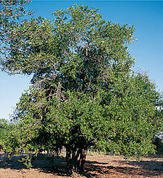
Name
Tamboti [Spirostachys africana]Description
The Tamboti Tree is deciduous and of medium height, the bark is characterisically rough and black. The milky latex can cause severe irritation to the skin and eyes. Furthermore, it is not used as a cooking fuel because it imparts unpleasant taints to the food. The species enjoys a degree of built-in protection against overuse by humans.
Kudu browse it, but hunters are careful when dressing a carcass in Tamboti country not to allow the rumenal contents to spoil the edible cuts. The heartwood is dark brown with darker longitudinal streaks that create beautiful markings. Figure mottled and banded, sometimes with visible growth increments.
It is a hard wood, lustrous and with a powerful, persistent, and pleasant scent sweeter than that of sandalwood. This pleasant odor will last a long time after the wood is cut. A piece of furniture made of it can scent a large room for a long time.
Flowers
Tamboti flowers in September and the pea sized seeds develop in three-lobed capsules which fall, when mature in November, to the leaf litter below. If you stand by a copse of Tamboti trees on a hot November day you may hear a distinctive rustling in the litter and if you look more closely you will see some flicking in the litter due to some seeds jumping intermittently.
Collect some of these jumpers and place them on a plate in the hot sun and the jumping becomes more invigorated. Open one carefully and you will find a small larva whose body suddenly contorts causing the bean to jump. This is the larvae of the small grey moth Emporia melanobasis which parasites the seed when still green.
Uses
Tamboti Trees are used mostly for carving, luxury furniture, turnery and curios. Because of its limited quantities, and the defectiveness of the tree, it is a rare wood and therefore sought for small fancy articles and high grade furniture.

